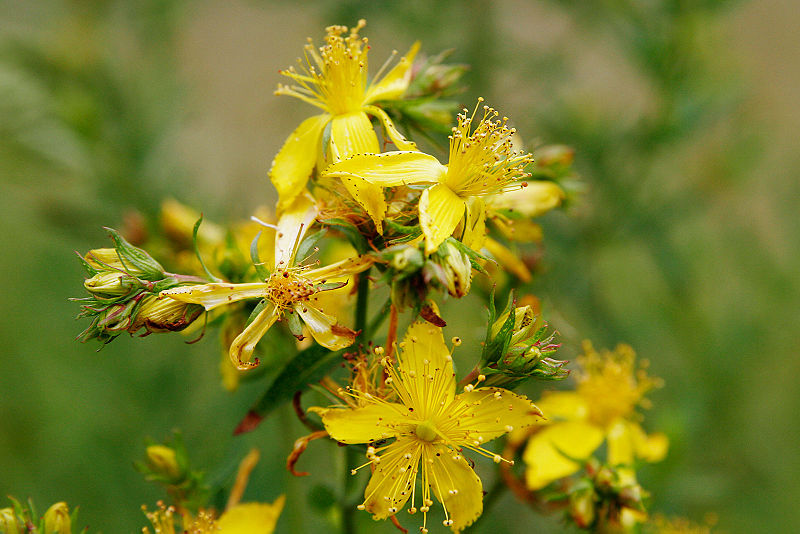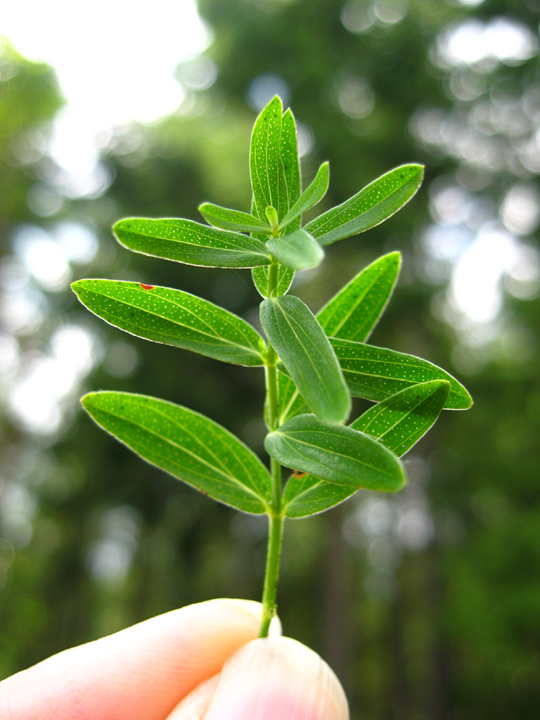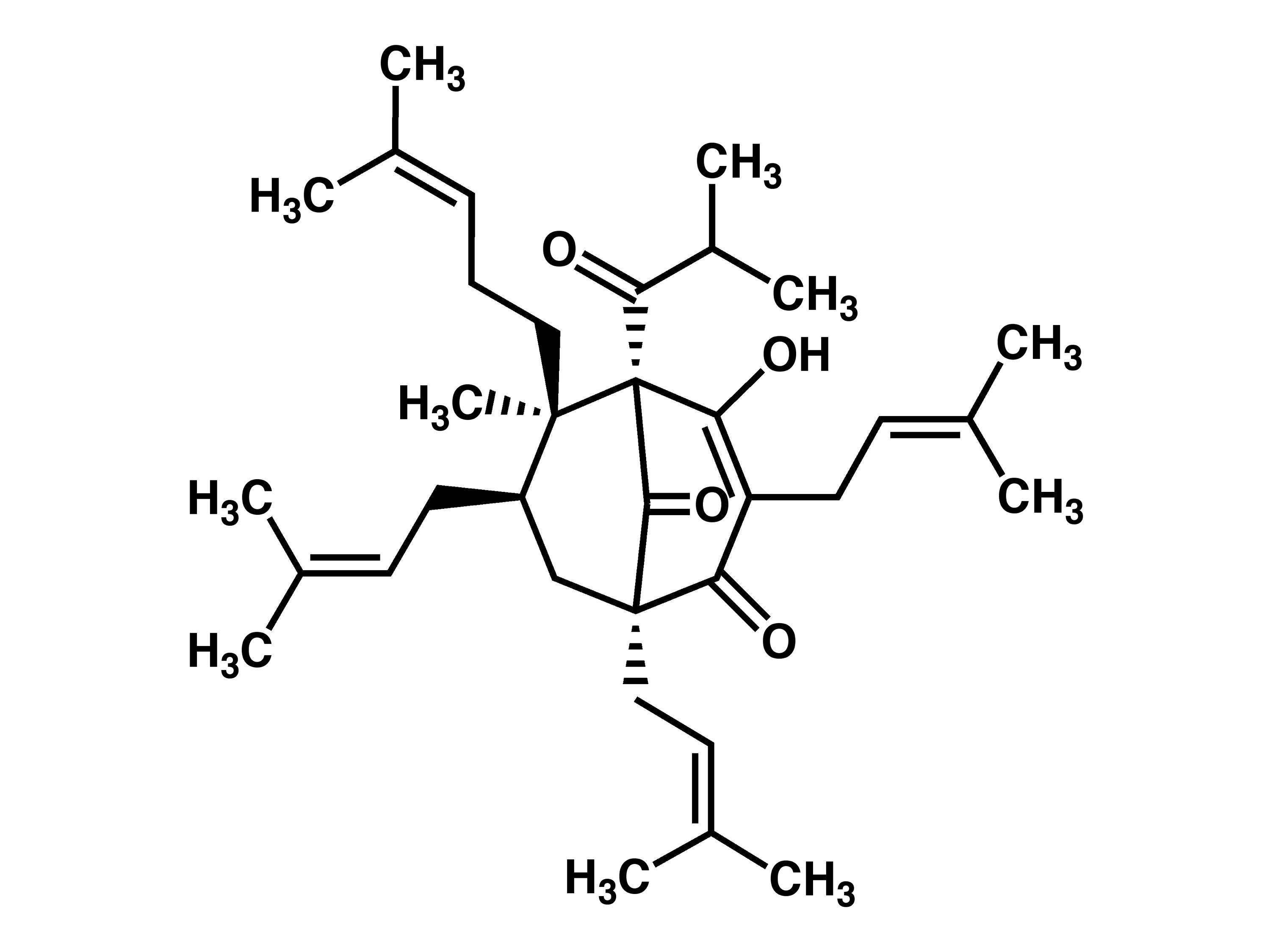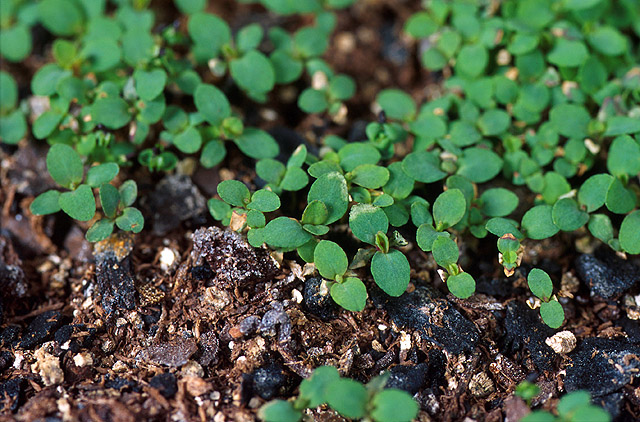St John's wort
| style="background:#Template:Taxobox colour;"|St John's wort | ||||||||||||||
|---|---|---|---|---|---|---|---|---|---|---|---|---|---|---|
 | ||||||||||||||
| style="background:#Template:Taxobox colour;" | Scientific classification | ||||||||||||||
| ||||||||||||||
| Binomial name | ||||||||||||||
| Hypericum perforatum L. |
|
WikiDoc Resources for St John's wort |
|
Articles |
|---|
|
Most recent articles on St John's wort Most cited articles on St John's wort |
|
Media |
|
Powerpoint slides on St John's wort |
|
Evidence Based Medicine |
|
Clinical Trials |
|
Ongoing Trials on St John's wort at Clinical Trials.gov Trial results on St John's wort Clinical Trials on St John's wort at Google
|
|
Guidelines / Policies / Govt |
|
US National Guidelines Clearinghouse on St John's wort NICE Guidance on St John's wort
|
|
Books |
|
News |
|
Commentary |
|
Definitions |
|
Patient Resources / Community |
|
Patient resources on St John's wort Discussion groups on St John's wort Patient Handouts on St John's wort Directions to Hospitals Treating St John's wort Risk calculators and risk factors for St John's wort
|
|
Healthcare Provider Resources |
|
Causes & Risk Factors for St John's wort |
|
Continuing Medical Education (CME) |
|
International |
|
|
|
Business |
|
Experimental / Informatics |
Editor-In-Chief: C. Michael Gibson, M.S., M.D. [4]
Overview
St John's wort (pronounced Template:IPA-en) used alone refers to the species Hypericum perforatum, also known as Tipton's Weed or Klamath weed, but, with qualifiers, is used to refer to any species of the genus Hypericum. Therefore, H. perforatum is sometimes called Common St John's wort to differentiate it. The species of Hypericum have been placed by some in the family Hypericaceae, but more recently have been included in the Clusiaceae. Approximately 370 species of the genus Hypericum exist worldwide with a native geographical distribution including temperate and subtropical regions of North America, Europe, Asia Minor, Russia, India and China.
The plant
Hypericum perforatum is a yellow-flowering, rhizomatous, perennial herb indigenous to Europe, which has been introduced to the Americas and grows wild in many meadows. The common name comes from its traditional flowering and harvesting on St John's day, 24 June. The genus name Hypericum is derived from the Greek words hyper (above) and eikon (picture), in reference to the traditional use of the plant to ward off evil, by hanging plants over a picture in the house during St John's day. The species name perforatum refers to the presence of small oil glands in the leaves that look like windows, which can be seen when they are held against the light.
Although Hypericum perforatum is grown commercially in some regions of south east Europe, it is listed as a noxious weed in more than twenty countries. In pastures, St John’s wort acts as both a toxic and invasive weed.[1] It replaces useful vegetation to the extent of making productive land unviable or acts as an alien species in natural ecosystems. Ingestion by livestock can cause photosensitization, central nervous system depression, spontaneous abortion, and can lead to death. Effective herbicides for control of Hypericum include 2,4-D, picloram, and glyphosate. In western North America three beetles Chrysolina quadrigemina, Chrysolina hyperici and Agrilus hyperici have been introduced as biocontrol agents.
Identification
St John’s wort can be visually recognized by leaf and flower type. Yellow, five petaled flowers approximately 20 mm across occur between late Spring and early to mid Summer. Leaves exhibit obvious translucent dots when held up to the light, giving them a ‘perforated’ appearance, hence the plant's Latin name. When flowers or seed pods are crushed, a reddish/purple liquid is produced.

Botanical description
St John's wort is a perennial plant with extensive, creeping rhizomes. Its stems are erect, branched in the upper section, and can grow to 1 m high. It has opposing, stalkless, narrow, oblong leaves which are 12 mm long or slightly larger. The leaves are yellow-green in color, with transparent dots throughout the tissue and occasionally with a few black dots on the lower surface. Its flowers measure up to 2.5 cm across, have five petals, and are colored bright yellow with conspicuous black dots. The flowers appear in broad cymes at the ends of the upper branches. The sepals are pointed, with glandular dots in the tissue. There are many stamens, which are united at the base into three bundles.
Chemical composition


Herb and flowers contain different flavonoids (rutin, hyperoside, isoquercetin, quercitrin, quercetin, I3,II8-biapigenin, amentoflavone, astilbin, miquelianin). Phenolic acids (chlorogenic acid, 3-O-coumaroylquinic acid). Different naphtodianthrones (hypericin, pseudohypericin, protohypericin, protopseudohypericin), phloroglucinols (hyperforin, adhyperforin). And also essential oils (composed mainly of sesquiterpenes). The naphthodianthrones hypericin and pseudohypericin along with the Phloroglucinol derivative hyperforin are thought to be the active compontents.
Ecology
St John’s wort has a complex life cycle that includes a mature plant cycle with vegetative and sexual reproduction. It thrives in areas with either a winter- or summer-dominant rainfall pattern; however, distribution is restricted by temperatures too low for seed germination or seedling survival. Altitudes greater than 1500 m, rainfall less than 500 mm, and a daily mean January temperature greater than 24 degrees are considered limiting thresholds. Depending on environmental and climatic conditions, and rosette age, St John’s wort will alter growth form and habit to promote survival. Summer rains are particularly effective in allowing the plant to grow vegetatively, following defoliation by insects or grazing.
Hypericum poisoning (livestock)
Clinical signs
At large doses, St John's wort is poisonous to grazing livestock (cattle, sheep, goats, horses).[5]

Behavioural signs of poisoning are general restlessness and skin irritation. Restlessness is often indicated by pawing of the ground, head shaking, head rubbing, and occasional hindlimb weakness with knuckling over, panting, confusion and depression. Mania and hyperactivity may also result including running in circles until exhausted. Observations of thick wort infestations by Australian graziers include the appearance of circular patches giving hillsides a ‘crop circle’ appearance, possibly from this phenomenon. Animals typically seek shade and have reduced appetite. Hypersensitivity to water has been noted, and convulsions may occur following a knock to the head. Although general aversion to water is noted, some may seek water for relief.
Severe skin irritation is physically apparent, with reddening of non-pigmented and unprotected areas. This subsequently leads to itch and rubbing, followed by further inflammation, exudation and scab formation. Lesions and inflammation that occur are said to resemble the conditions seen in foot and mouth disease. Sheep have been observed to have face swelling, dermatitis, and wool falling off due to rubbing. Lactating animals may cease or have reduced milk production, pregnant animals may abort. Lesions on udders are often apparent. Horses may show signs of anorexia, depression (with a comatose state), dilated pupils, and injected conjunctiva.
Early diagnosis
Increased respiration and heart rate is typically observed while one of the early signs of St John’s wort poisoning is an abnormal increase in body temperature. Affected animals will lose weight, or fail to gain weight; young animals more affected than old animals. In severe cases death may occur, as a direct result of starvation, or because of secondary disease or septicaemia of lesions. Some affected animals may accidentally drown. Poor performance of suckling lambs (pigmented and non-pigmented) has been noted, suggesting a reduction in the milk production, or the transmission of a toxin in the milk.
Photosensitisation
Most clinical signs are caused by photosensitisation.[6] Plants may induce either primary or secondary photosensitisation: primary photosensitisation directly from chemicals contained in ingested plants, or secondary photosensitisation from plant-associated damage to the liver. Araya and Ford (1981) explored changes in liver function and concluded there was no evidence of Hypericum-related effect on the excretory capacity of the liver, or any interference was minimal and temporary. However, at high and continuous dose rates changes in blood plasma indicative of some liver damage have been observed.
Photosensitisation causes skin inflammation by a mechanism involving a pigment or photodynamic compound, which when activated by a certain wavelength of light leads to oxidation reactions in vivo. This leads to lesions of tissue, particularly noticeable on and around parts of skin exposed to light. Lightly covered or poorly pigmented areas are most conspicuous. Removal of affected animals from sunlight results in reduced symptoms of poisoning.
Use as spice
St John's wort is sometimes used for flavouring distilled spirits.
Use as antidepressant
St John's wort is today most widely known as a herbal treatment for depression. In some countries, such as Germany, it is commonly prescribed for mild depression, especially in children, adolescents, and where cost is a concern.[7] Standardized extracts are generally available over the counter – however, in some countries (such as Ireland) a prescription is required. Extracts are usually in tablet or capsule form, and also in teabags and tinctures.
Clinical evidence

Clinical studies of St John's wort preparations have mainly focused on the efficacy of the herb in clinical depression. Several studies and meta-analyses have found it to be effective in the treatment of mild to moderate depression, with fewer side effects than many conventional antidepressants. Other studies, including a major National Institutes of Health (NIH) study that focused on participants with major depression, have shown no improvements.[8]
Evidence for efficacy
An early meta-study indicated that extracts of Hypericum may be more efficacious than placebo for the treatment of mild to moderately severe depressive disorders.[9] This study, which covered the results from 23 smaller, earlier studies, is perhaps the most often cited by manufacturers and other supporters of St John's wort.
This study was later updated to include further studies, for a total of 27, to form a Cochrane Review. The updated review found that Hypericum preparations were significantly superior to placebo (rate ratio 2.47; 95% confidence interval 1.69 to 3.61) and similarly effective as standard antidepressants (single preparations 1.01; 0.87 to 1.16, combinations 1.52; 0.78 to 2.94).[10]
Another meta-analysis, with stricter inclusion criteria, found that Hypericum was more efficacious than placebo; and as efficacious as tricyclic antidepressants, with fewer adverse drug reactions. This meta-analysis showed that the response rate for St John’s wort was significantly greater than that for placebo (73.2 versus 37.9%, respectively, relative risk 1.48 and 95% CI 1.03–1.92) and similar to that observed with tricyclic antidepressants (64 versus 66.4% for St John’s wort and tricyclic antidepressants, respectively, relative risk 1.11 and 95% CI 0.92–1.29).[11]
There are some trials that show effectiveness of St. John's wort, beyond a placebo effect, on treating different types of depression.[12][13][14][15][16][17][18] A 2006 study involving 150 patients with minor depressive symptoms or dysthymia found that St John's wort has a clinically significant effect in patients with minor depression, but not those suffering from dysthymia. It was concluded that St John's wort can be effective in the treatment of people with minor depression with a Hamilton Depression Scale for Depression (HAM-D) score of up to 17.[19] The British Medical Journal has recommended that the results of the randomized controlled trials of St John's Wort should be interpreted with caution, as many did not use standardised preparations or homogenous populations, and doses of antidepressants varied.[9] A major review of the efficacy of St. John's Wort cautioned that the pharmaceutical quality of various preparations on the market may vary considerably.[10]
Evidence against efficacy for Major Depressive Disorder
A major study funded by the NIH in the United States failed to find any evidence that Hypericum extract of St John's wort was effective in treating moderate to severe cases of major depression (Hypericum Depression Trial Study Group, 2002). This study involved 340 patients, diagnosed with Major Depressive Disorder based on DSM-IV criteria and assessed using Hamilton Depression Rating Scale (HAM-D) and Clinical Global Impression (CGI) scores. The trial was a multi-centre randomised double-blind placebo-controlled trial, comparing one preparation of St John's wort (Li 160) to the antidepressant sertraline, and to placebo. No statistically significant effect was garnered from Li 160. Sertraline was also no better than placebo in this study, based on the primary outcome measure (the HAM-D).[8] The authors of the study themselves, as well as several others pointed out the low assay sensitivity of this study, and how only limited conclusions can be drawn from its results.[20] [21]
Pharmacology
The exact mechanism by which St John's wort — and even conventional antidepressants — functions is unclear and subject to conjecture. The St John's wort mechanism is believed to involve inhibition of serotonin (5-HT) reuptake, much like the conventional selective serotonin reuptake inhibitor (SSRI) antidepressants.[22] The major active antidepressive constituents in St John's wort are thought to be hyperforin and hypericin, although other biologically active constituents present, for example, flavonoids and tannins, may also be involved.[23][24][25]
Some believe that hyperforin is the major constituent responsible for antidepressant activity, and it has been shown to inhibit the uptake of 5-HT, dopamine, noradrenaline, GABA and glutamate. [24] On the other hand, a hyperforin free extract of St John's wort (Ze 117 - Remotiv) has been shown to still have significant antidepressive effects.[12][13]
Other medical uses
In addition to antidepressant, there are other medical uses for St John's wort:
It may also decrease alcohol intake. The constituent hyperforin, (found in the plant), appears to be responsible for decreasing alcohol consumption.[26]
The aerial parts of the plant can be cut and dried for later use in the form of herbal tea with pleasant, though somewhat bitter, taste and for its medicinal properties.
Hyperforin, a major constituent, has also been found to have excellent antibacterial properties; in ultrapurified form a concentration of 0.1 mg/ml kills methicillin-resistant forms of Staphylococcus aureus (MRSA).[27]
Adverse effects
St John's wort is generally well tolerated, with an adverse effect profile similar to placebo.[28] The most common adverse effects reported are gastrointestinal symptoms, dizziness, confusion, tiredness and sedation.[29]
St John's wort may rarely cause photosensitivity. This can lead to visual sensitivity to light and to sunburns in situations that would not normally cause them.[28] Related to this, researchers at Fordham University, New York, showed in laboratory experiments that the drug reacts with light, both visible and ultraviolet, to produce free radicals, molecules that can damage the cells of the body.[30] These can react with vital proteins in the eye which, if damaged, precipitate out causing cataracts.
Some research shows that St John's wort may adversely affect fertility in both men and women.[31]
St John's wort has been known to instigate mania in bipolar patients and for these people it should be used with caution, just as with any anti-depressant.[32][33]
Caution is also recommended when discontinuing use.
Also, it is important to note that St John's Wort interacts with many drugs, so if a person is taking any other medications, they should talk with a doctor or pharmacist to see if it may interact.
Drug interactions
Pharmacokinetic interactions
St John's wort has been shown to cause multiple drug interactions mainly through induction of the cytochrome P450 enzyme CYP3A4, but also CYP2C9. This results in the increased metabolism of those drugs, resulting in decreased concentration and clinical effect. The principal constituent thought to be responsible is hyperforin.
| Class | Drugs |
|---|---|
| antiepileptics | carbamazepine, phenytoin |
| antiretrovirals | non-nucleoside reverse transcriptase inhibitors, protease inhibitors |
| benzodiazepines | alprazolam, midazolam |
| hormonal contraception | combined oral contraceptives |
| immunosuppressants | calcineurin inhibitors, ciclosporin, tacrolimus |
| others | digoxin, methadone, omeprazole, phenobarbitone, theophylline, warfarin, levodopa |
| Reference: Rossi, 2005 | |
For a complete list, see CYP3A4#CYP3A4 ligands and CYP2C9#CYP2C9 Ligands. For further updating on interactions and appropriate management, see Herbological.com - S:t John's Wort Interactions table.
Contraceptives
St John's wort may interact with birth control pills and may reduce the effectiveness of oral contraceptives by up to 50%.[34]
Pharmacodynamic interactions
St John's wort may also contribute to serotonin syndrome in combination with other drugs which may elevate 5-HT (serotonin) levels in the central nervous system (CNS).[35]
| Class | Drugs |
|---|---|
| antidepressants | MAOIs, TCAs, SSRIs, mirtazapine, venlafaxine |
| opioids | tramadol, pethidine |
| CNS stimulants | phentermine, diethylpropion, amphetamines, sibutramine |
| 5-HT1 agonists | triptans |
| illicit drugs | methylenedioxymethamphetamine (MDMA), lysergic acid diethylamide (LSD), cocaine |
| others | selegiline, tryptophan, buspirone, lithium, linezolid, dextromethorphan, 5-HTP |
| Reference: Rossi, 2005 | |
History
The first recorded use of Hypericum for medicinal purposes dates back to ancient Greece, and it has been used ever since. Hypericum was also used by Native Americans internally as an abortifacient and externally as an anti-inflammatory, astringent, and antiseptic.
Its use as a herbal tea has long been enjoyed.
The flowers and stems of St John's wort have also been used to produce red and yellow dyes.
References
- ↑ St John's wort
- ↑ Umek A, Kreft S, Kartnig T, Heydel B.Quantitative phytochemical analyses of six hypericum species growing in slovenia. Planta Med. 1999;65:388-90 [1]
- ↑ Tatsis EC, Boeren S, Exarchou V, Troganis AN, Vervoort J, Gerothanassis IP.Identification of the major constituents of Hypericum perforatum by LC/SPE/NMR and/or LC/MS. Phytochemistry. 2007;68:383-93. [2]
- ↑ Schwob I, Bessière JM, Viano J.Composition of the essential oils of Hypericum perforatum L. from southeastern France.C R Biol. 2002;325:781-5.
- ↑ St John's wort
- ↑ St John's wort
- ↑ Fegert JM, Kölch M, Zito JM, Glaeske G, Janhsen K (2006). "Antidepressant use in children and adolescents in Germany". J Child Adolesc Psychopharmacol. 16 (1–2): 197–206. doi:10.1089/cap.2006.16.197. PMID 16553540.
- ↑ 8.0 8.1 Hypericum Depression Trial Study Group (2002). "Effect of Hypericum perforatum (St John's wort) in major depressive disorder: a randomized controlled trial". JAMA. 287 (14): 1807–14. doi:10.1001/jama.287.14.1807. PMID 11939866.
- ↑ 9.0 9.1 Linde K, Ramirez G, Mulrow CD, Pauls A, Weidenhammer W, Melchart D (1996). "St John's wort for depression--an overview and meta-analysis of randomised clinical trials". BMJ. 313 (7052): 253–8. PMID 8704532.
- ↑ 10.0 10.1 Linde K, Mulrow CD, Berner M, Egger M (2005). "St John's wort for depression". Cochrane Database Syst Rev (2): CD000448. doi:10.1002/14651858.CD000448.pub2. PMID 15846605.
- ↑ Kim HL, Streltzer J, Goebert D (1999). "St. John's wort for depression: a meta-analysis of well-defined clinical trials". J. Nerv. Ment. Dis. 187 (9): 532–8. PMID 10496508.
- ↑ 12.0 12.1 Woelk H (2000). "Comparison of St John's wort and imipramine for treating depression: randomised controlled trial". BMJ. 321 (7260): 536–9. doi:10.1136/bmj.321.7260.536. PMID 10968813.
- ↑ 13.0 13.1 Schrader E (2000). "Equivalence of St John's wort extract (Ze 117) and fluoxetine: a randomized, controlled study in mild-moderate depression". Int Clin Psychopharmacol. 15 (2): 61–8. PMID 10759336.
- ↑ Laakmann G, Schüle C, Baghai T, Kieser M (1998). "St. John's wort in mild to moderate depression: the relevance of hyperforin for the clinical efficacy". Pharmacopsychiatry. 31 Suppl 1: 54–9. PMID 9684948.
- ↑ Harrer G, Schmidt U, Kuhn U, Biller A (1999). "Comparison of equivalence between the St. John's wort extract LoHyp-57 and fluoxetine". Arzneimittelforschung. 49 (4): 289–96. PMID 10337446.
- ↑ Philipp M, Kohnen R, Hiller KO (1999). "Hypericum extract versus imipramine or placebo in patients with moderate depression: randomised multicentre study of treatment for eight weeks". BMJ. 319 (7224): 1534–8. PMID 10591711.
- ↑ Szegedi A, Kohnen R, Dienel A, Kieser M (2005). "Acute treatment of moderate to severe depression with hypericum extract WS 5570 (St John's wort): randomised controlled double blind non-inferiority trial versus paroxetine". BMJ. 330 (7490): 503. doi:10.1136/bmj.38356.655266.82. PMID 15708844.
- ↑ Lecrubier Y, Clerc G, Didi R, Kieser M (2002). "Efficacy of St. John's wort extract WS 5570 in major depression: a double-blind, placebo-controlled trial". Am J Psychiatry. 159 (8): 1361–6. doi:10.1176/appi.ajp.159.8.1361. PMID 12153829.
- ↑ Randløv C, Mehlsen J, Thomsen CF, Hedman C, von Fircks H, Winther K (2006). "The efficacy of St. John's Wort in patients with minor depressive symptoms or dysthymia--a double-blind placebo-controlled study". Phytomedicine. 13 (4): 215–21. doi:10.1016/j.phymed.2005.11.006. PMID 16423519.
- ↑ Kupfer DJ, Frank E (2002). "Placebo in clinical trials for depression: complexity and necessity". JAMA. 287 (23): 1853–4. doi:10.1001/jama.287.14.1853. PMID 11939872.
- ↑ Spielmans GI (2002). "St John's wort and depression". JAMA. 288 (4): 448–9. PMID 12132963.
- ↑ Leuner K, Kazanski V, Müller M, Essin K, Henke B, Gollasch M, Harteneck C, Müller WE (2007). "Hyperforin--a key constituent of St. John's wort specifically activates TRPC6 channels". FASEB J. 21 (14): 4101–11. doi:10.1096/fj.07-8110com. PMID 17666455.
- ↑ Nahrstedt A, Butterweck V (1997). "Biologically active and other chemical constituents of the herb of Hypericum perforatum L". Pharmacopsychiatry. 30 Suppl 2: 129–34. PMID 9342774.
- ↑ 24.0 24.1 Butterweck V (2003). "Mechanism of action of St John's wort in depression : what is known?". CNS Drugs. 17 (8): 539–62. doi:10.2165/00023210-200317080-00001. PMID 12775192.
- ↑ Müller WE (2003). "Current St John's wort research from mode of action to clinical efficacy". Pharmacol. Res. 47 (2): 101–9. doi:10.1016/S1043-6618(02)00266-9. PMID 12543057.
- ↑ UK Bradford School of Pharmacy
- ↑ wissenschaft-online.de (in German)
- ↑ 28.0 28.1 Ernst E, Rand JI, Barnes J, Stevinson C (1998). Adverse effects profile of the herbal antidepressant St. John's wort (Hypericum perforatum L.). Eur J Clin Pharmacol 54 (8), 589-94.
- ↑ Barnes J, Anderson LA, Phillipson JD (2002). Herbal Medicines: A guide for healthcare professionals (2 ed.) London: Pharmaceutical Press. ISBN 0-85369-474-5.
- ↑ Health: Anti-depressant herb may harm sight
- ↑ Stahl, SM (2000). Essential psychopharmacology: neuroscientific basis and practical applications, Cambridge: Cambridge University Press, 2nd ed, page 266.
- ↑ St. John's wort - bipolar disorder - mania trigger - warnings
- ↑ Bipolar Focus - Bipolar Disorder (Manic Depression) News, Information and Support
- ↑ [3]
- ↑ Rossi S (Ed.) (2005). Australian Medicines Handbook 2005. Adelaide: Australian Medicines Handbook. ISBN 0-9578521-9-3.
Further reading
- British Herbal Medicine Association Scientific Committee (1983). British Herbal Pharmacopoeia. West Yorkshire: British Herbal Medicine Association. ISBN 0-903032-07-4
See also
External links
- QuackWatch article on St John's wort Criticism of the use of St. John's wort to treat depression. Includes Food and Drug Administration (FDA) warnings about interference with treatments for heart disease, some cancers, AIDS and others.
bg:Жълт кантарион
da:Prikbladet Perikon
de:Echtes Johanniskraut
el:Βάλσαμο
eo:Trapunkta hiperiko
fa:چای کوهی
it:Hypericum perforatum
lv:Divšķautņu asinszāle
lt:Paprastoji jonažolė
li:Dónderkroed
hu:Közönséges orbáncfű
nl:Sint-janskruid
no:Prikkperikum
sr:Kantarion
sl:Šentjanževka
fi:Mäkikuisma
sv:Johannesört
uk:Звіробій звичайний